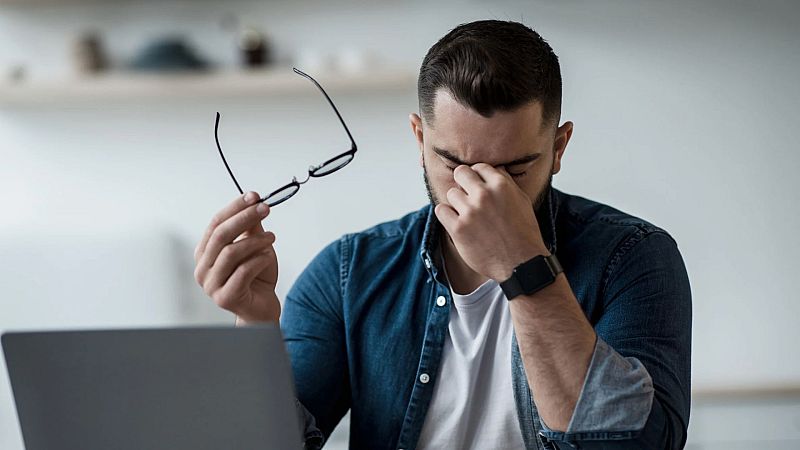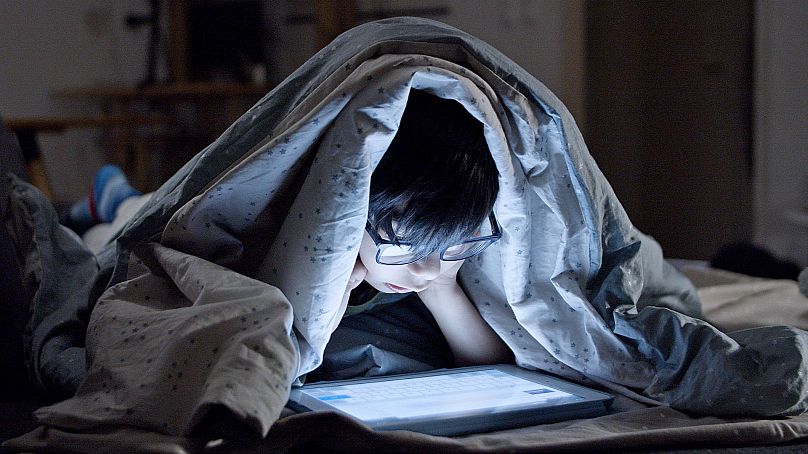
Screens have become an inescapable part of our daily lives. From replying to work emails on a laptop to doomscrolling through brain rot on TikTok, the average adult now racks up more than six hours of screen time every day – nearly a third of our waking lives.
The shift to remote and hybrid working has only intensified this. With Zoom meetings, Slack pings, Google Docs, and Teams chats becoming the new office norm, our eyes rarely get a break.
The big problem, according to UK-based optometrist Shahina Pardhan, is the strain we put on our eye muscles.
"When you're looking at a digital screen up close, like a smartphone, your eyes have to focus at that short distance. To do that, they use muscle power, specifically the ciliary muscle inside the eye," Pardhan,** who leads the Director of Vision and Eye Research Institute at Anglia Ruskin University, told Euronews Health.
"With sustained use, especially as we get older and those muscles don’t work as well as they used to, the muscle gets really tired," she added.
The pressure can have a serious impact on our wellbeing. While estimates vary, many people have Computer Vision Syndrome (CVS), also known as digital eye strain, with symptoms ranging from dry, irritated eyes to headaches, blurred vision, and fatigue.
But these symptoms don't have to be inevitable. Here are five evidence-based tips to give your eyes a break – and protect your vision for the long haul.
1. Practice the 20-20-20 rule
One of the most widely recommended techniques to reduce digital eye strain is the 20-20-20 rule, proposed by the American Optometric Association (AOA).
It suggests that every 20 minutes, you should look at something 20 feet away for at least 20 seconds.
Studies have shown that teaching this technique to people with CVS helped to ease their dry eye symptoms.
"When you look at something around 20 feet away, you’re actually relaxing those eye muscles," Pardhan said. "Even just 20 seconds of that can really help".
However, the results are mixed on whether the method helps with tear film stability, which helps ensure eyes stay lubricated and vision stays clear.

2. Optimise your work station and screen position
The way your workspace is set up can make a huge difference to your eye health. Poor lighting, bad screen angles, and reflective glare are some of the biggest culprits behind digital eye strain.
"It's really important to keep your screen at eye level," Pardhan said, regardless of whether it's your smartphone or computer.
"Tilting your head down can put a lot of strain on the neck, increasing stress on the spine and shoulders".
Additionally, bright overhead lights or sunlight pouring through a window can reflect off of your screen, forcing your eyes to work harder and causing discomfort. To cut down on glare, try using an anti-reflective screen filter or adjust the lighting in your room so it’s soft and indirect.
If you work near a window, avoid placing your screen directly in front of or behind it.
3. Blink more than you think
Blinking lubricates the eyes by spreading tears across the cornea. But researchers say that when we’re glued to screens, our blink rate can drop by as much as 66 per cent, raising the risk of getting dry eyes.
Studies show that the average person blinks 15 to 20 times per minute. But this rate drops significantly when working at a computer, to around four to six times per minute.
To keep your eyes from drying out, try sticking a small reminder on your monitor or around your workplace – even something simple like “Blink!” or a visual cue that nudges you to give your eyes a break.
And also don't forget your surroundings. If your space is dry, for example if you have central heating or air conditioning, keeping your environment well-hydrated can also help.
“Just having a humidifier or even just a bowl of water or a vase of flowers with water will humidify the air and it won’t dry out the atmosphere as much," Pardhan said.

4. Use blue light filters
Blue light – the high-energy visible light emitted by LED screens – is more than just a sleep disruptor. Studies show that prolonged exposure to blue light, particularly in the 400 to 470 nanometre range, can contribute to retinal stress and damage, increasing the risk of eye discomfort.
Pardhan said that "very bright screens – especially when used in a dark environment – can be harsh on the eyes. They cause your pupils to contract due to the glare, which is the opposite of what your eyes naturally need in low-light settings".
Thankfully, most modern devices offer night mode or blue light filter settings. Activating these reduces blue light exposure, especially in low-light environments. Additionally, wearing blue light blocking glasses, especially at nighttime, can provide extra protection.
Keep in mind, though, that blue light filters can only do so much. Research indicates they do not protect against serious eye diseases such as age-related macular degeneration.
5. Use your devices more mindfully
Even when we're off the clock, many of us instinctively turn to screens for downtime – scrolling through social media, binge-watching shows, or falling into YouTube rabbit holes. But those micro-moments of leisure can quietly add up.
Cutting back on non-essential screen time, especially outside of work hours, can give your eyes the rest they desperately need. A good starting point is to use your device’s built-in tools that track how much time you're spending on different apps and websites.
There are also smartphone apps designed to help reduce screen time. The Forest app, for example, lets you “plant a tree” that grows the longer you stay off your phone. If you give in and start scrolling, your tree dies. Users say it is oddly motivating – and it even helps plant real trees through a partner initiative.
Another option is OneSec, which adds a one-second delay before opening apps like Instagram or TikTok. That tiny pause can help disrupt your autopilot habit and give your brain just enough time to ask: Do I really want to open this right now?







